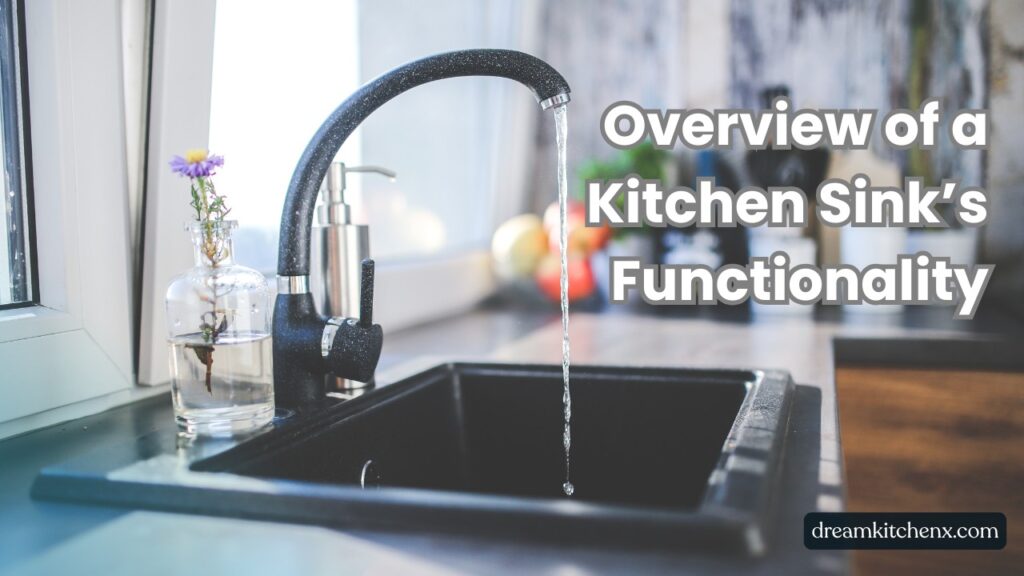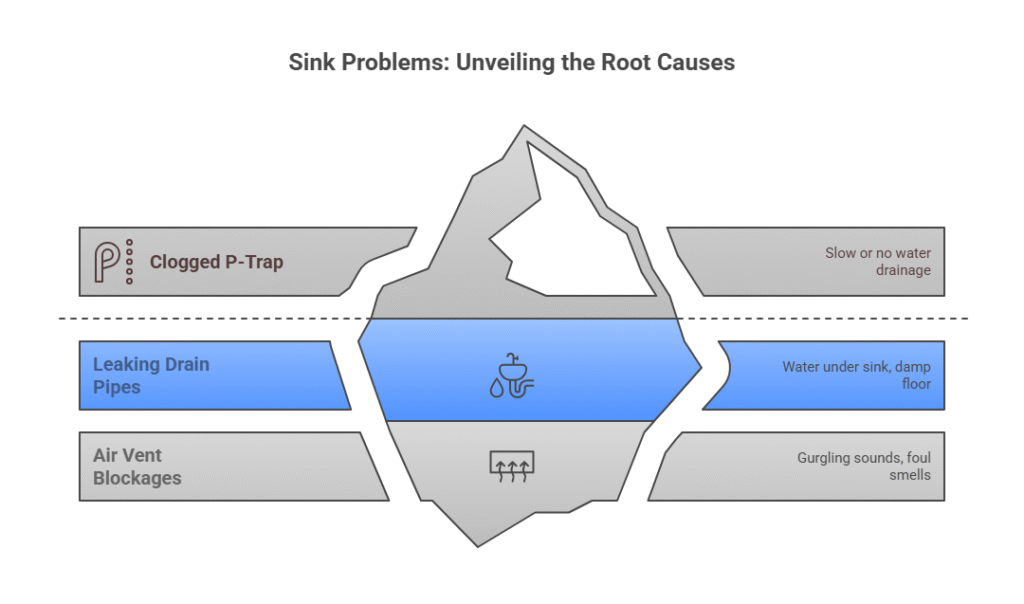A kitchen sink works by using gravity and water pressure to move clean water in and dirty water out through a system of pipes, traps, and vents.
Your kitchen sink is one of the hardest-working fixtures in your home, yet how it all works can feel like a mystery. Ever wondered where the water goes, or why that U-shaped pipe is always under the sink? Don’t worry—you’re not alone. Many homeowners are confused by the pipes, valves, and drainage system that keep everything running smoothly.
In this beginner-friendly guide, you’ll learn exactly how a kitchen sink works—from water flow to waste removal. We’ll break it down step by step, using plain language, clear examples, and even diagrams to make it simple to follow. Let’s walk through each part so you can finally understand what’s really happening under your sink.
Overview of a Kitchen Sink’s Functionality

Basic Water Flow and Drainage
Your kitchen sink works using two main systems: water supply and water drainage. Clean water flows into the faucet from your home’s main water line. When you turn on the faucet, water is pushed through by pressure. It exits through the spout into the sink basin.
Once used, the water flows down the drain. Gravity pulls it into a set of pipes under the sink. These pipes connect to your home’s larger drainage system. The water then travels to your city’s sewer or a septic tank.
Everything works together. Pressure brings water in. Gravity and pipe angles help water flow out.
Cold and Hot Water Supply
Kitchen sinks connect to both cold and hot water supply lines. These are small metal or plastic tubes under the sink. One line brings in cold water directly from the main supply. The other runs through your home’s water heater before reaching the faucet.
Each faucet has valves that control these lines. Turning the faucet handle lets cold, hot, or mixed water flow out. Most homes use a mixing valve inside the faucet, which blends both to the right temperature.
If you want to learn more about how plumbing systems deliver water, check this helpful resource from puget sound plumbing.
Understanding the Key Components

Faucet Mechanism
The faucet is the most used part of the sink. Inside it are small valves that open and close as you turn the handle. These valves control how much water flows and mix hot and cold water for the right temperature.
Some faucets have aerators at the spout tip. These mix air into the water stream to save water and reduce splashing.
Sink Basin Design
The sink basin is the bowl-shaped part that holds the water. It’s made from metal, ceramic, or even stone. It includes a slight slope toward the drain to help water flow out easily.
Most basins have an overflow hole. This prevents water from spilling over if the faucet is left on by accident.
Drain Assembly and Strainer
The drain is the opening where water exits the basin. A strainer basket sits inside to catch food or debris. Beneath the strainer is the tailpiece—a straight pipe that connects to the rest of the drain system.
The drain also includes a rubber gasket and locking nut to prevent leaks.
P-Trap and Waste Pipe
Below the sink is the P-trap. It’s a U-shaped pipe that always holds water. This water acts as a seal, blocking bad smells from coming back up the drain. The P-trap connects to a horizontal waste pipe that runs toward the wall.
This setup helps move wastewater to the main sewer line. If clogged, it’s often the P-trap that needs cleaning.
Ventilation and Airflow
Your sink’s drain system connects to a vent pipe. This pipe lets air flow into the system. It keeps water flowing smoothly by preventing vacuum pressure inside the drain lines.
Without a vent, draining would be slow, noisy, and might pull water out of the P-trap.
Step-by-Step: How a Kitchen Sink Works
Water Supply and Usage
When you turn on the faucet, clean water rushes through pipes under pressure. The faucet valves open, allowing water to exit through the spout. If you choose hot water, it first travels through your water heater.
Once it enters the basin, the water is used for washing hands, rinsing dishes, or cleaning food.
Wastewater Drainage Explained
After use, water flows into the drain. Gravity pulls it down through the strainer, tailpiece, and P-trap. It then enters the waste pipe and continues into the main drainage system.
The water moves quickly, helped by the downward slope of the pipes and the force of gravity.
Role of the Vent Pipe
As wastewater flows out, it creates air pressure in the pipes. The vent pipe releases this pressure by allowing air in. This keeps the flow steady and stops gurgling noises or backflow.
Without proper venting, your sink may drain slowly or trap unpleasant smells.
Table: Components and Their Functions
| Component | Function |
|---|---|
| Faucet | Controls water flow and mixes hot/cold water |
| Sink Basin | Holds water and guides it to the drain |
| Strainer | Catches debris and keeps clogs from forming |
| P-Trap | Traps water to block sewer gas from entering the home |
| Waste Pipe | Carries wastewater to the home’s drain system |
| Vent Pipe | Balances air pressure to allow smooth drainage |
Anatomy of a Kitchen Sink
To fully understand how a kitchen sink works, it’s helpful to see how all the parts fit together. Imagine a cutaway view of your kitchen sink showing the faucet, basin, drain, P-trap, and vent pipe all connected. Each part plays a key role in water flow, drainage, and air pressure.
If you’re planning a DIY repair or installation, a visual guide like this can be essential. You can find a good example in this interactive sink diagram from Mr. Rooter, which labels every part with a short explanation.
Make sure to refer to an image while reading or repairing so you don’t mix up parts or connections.
Common Problems those Affect the Sink’s Function

Clogs in the P-Trap
One of the most frequent problems is a clogged P-trap. This U-shaped pipe collects food, grease, and soap scum over time. When it clogs, water drains slowly or not at all. A simple fix is to remove and clean the P-trap manually. Always place a bucket underneath before unscrewing it.
To prevent clogs, avoid pouring oil or coffee grounds down the sink. You can also use mesh strainers to catch large debris.
Leaking Drain Pipes
Leaks are another common issue. They usually happen around joints in the drain pipes or at the bottom of the strainer. You might notice water under the sink or a damp cabinet floor.
Tightening the fittings or replacing old gaskets often solves the problem. Use plumber’s tape for a better seal. If leaks persist, you might need to replace damaged pipe sections.
Air Vent Blockages
If the vent pipe is blocked, your sink may drain slowly or make gurgling sounds. The air needed to balance pressure inside the pipes can’t flow freely. This may also cause foul smells from the drain.
Vent blockages often occur due to debris, nesting animals, or roof damage. A licensed plumber may need to inspect and clear the vent pipe. Learn more about venting issues from Family Handyman’s plumbing guide.
Components and Common Problems
| Component | Common Problem | Effect on Function | Quick Fix |
|---|---|---|---|
| P-Trap | Food or grease clogs | Water backs up | Remove and clean manually |
| Drain Pipe | Loose connections | Water leaks below the sink | Tighten fittings or use plumber’s tape |
| Strainer | Worn rubber gasket | Leaks around drain | Replace gasket |
| Vent Pipe | Blocked or clogged | Gurgling or slow drainage | Call plumber to clear the vent |
| Faucet Valve | Wear or corrosion | Leaky faucet or weak water flow | Replace valve or cartridge |
FAQs
Why is there a U-shaped pipe under my sink?
That U-shaped pipe is called a P-trap. It holds a small amount of water that blocks sewer gases from coming back up into your home. It also helps trap small objects if something falls down the drain. Without it, your kitchen would likely smell unpleasant.
You can learn more about P-traps from this guide on The Spruce.
Can a sink work without a vent pipe?
No, every sink needs a vent pipe. It allows air into the drain line so water flows freely. Without a vent, your sink may drain slowly, make gurgling noises, or smell bad. In some cases, an air admittance valve (AAV) can be used if a standard vent isn’t possible, but this should follow plumbing codes.
What causes slow sink drainage?
Slow drainage is usually caused by clogs in the P-trap or nearby pipes. Grease, food scraps, and soap scum can build up over time. Blocked vent pipes can also make water drain more slowly.
Using a drain snake or cleaning the P-trap are quick solutions. If you’re unsure where the clog is, calling a plumber may save time.
How often should sink parts be cleaned?
It’s a good habit to check and clean the drain and P-trap every 3 to 6 months. This prevents clogs and keeps everything running smoothly. Wipe down faucet aerators too—they can collect mineral deposits that reduce water flow.
Regular maintenance can add years to your plumbing. Bob Vila’s home maintenance checklist includes good reminders for kitchen upkeep.
Can I replace sink parts myself?
Yes, many parts like faucets, strainers, and P-traps can be replaced with basic tools. Just make sure to turn off the water before you start. Look up your sink model online or refer to your owner’s manual for part numbers and installation tips.
If the repair involves cutting pipes or working inside walls, it’s safer to hire a professional plumber.
Conclusion
Understanding how your kitchen sink works makes everyday problems easier to handle. With a clear idea of how water flows, what each part does, and how to spot trouble early, you can avoid expensive repairs. This guide covered the basic components, common issues, and simple maintenance tips.
To keep your kitchen plumbing running smoothly:
- Avoid pouring grease or solids down the drain.
- Clean the P-trap and strainer regularly.
- Check for slow drainage or leaks as early signs of trouble.
- Use vent pipes or AAVs for proper airflow.
When in doubt, don’t hesitate to reach out to a licensed plumber to protect your home’s plumbing system.
Kitchen Sink Maintenance Summary
| Task | Frequency | Tools Needed | Benefit |
|---|---|---|---|
| Clean P-trap and strainer | Every 3–6 months | Bucket, wrench | Prevents clogs and odors |
| Wipe faucet aerators | Monthly | Old toothbrush, vinegar | Improves water pressure |
| Check for leaks | Monthly | Flashlight | Stops damage before it spreads |
| Use mesh drain catchers | Daily | Mesh strainer | Stops food debris from entering |
| Inspect vent performance | Yearly | N/A | Maintains proper drainage airflow |